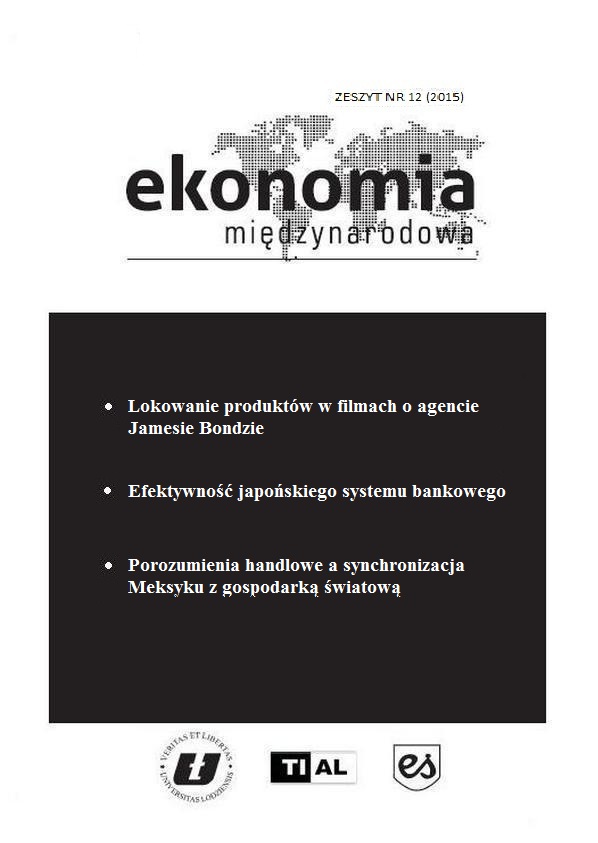Efficiency frontier on Japanese banking system
DOI:
https://doi.org/10.18778/2082-4440.12.03Słowa kluczowe:
data envelopment analysis, free disposability hull, efficiency frontier, distance, financial efficiency, super efficiencyAbstrakt
Since the emergence of the efficiency frontier techniques, a series of comparisons between the methods that led to the resultant efficiency has been presented. In this paper, data from 99 Japanese banks are used in order to prove the applicability of efficiency frontier analysis on the East-Asian financial system and to reveal the differences between inter and intra-regional banks, showing the effect of the present financial crisis on the efficiency of the studied banks. DEA and FDH are used to determine the technical and scale efficiency of the analyzed banks and also it compares fully efficient banks by ranking them through the super-efficiency notion.
Bibliografia
Barros C., Managi S. (2009), Productivity growth and biased technological change: Credit banks in Japan, Journal of International Financial Markets, Institutions and Money, 924–936.
Google Scholar
DOI: https://doi.org/10.1016/j.intfin.2009.07.006
Bogetoft P., Otto L. (2010), Benchmarking with DEA, SFA and R, Springer, New York.
Google Scholar
DOI: https://doi.org/10.1007/978-1-4419-7961-2
Charnes A., Cooper W.W. (1990), Polyhedral cone-ratio DEA models with an illustrative application to large commercial banks, Journal of Econometrics 46, 73–91.
Google Scholar
DOI: https://doi.org/10.1016/0304-4076(90)90048-X
Coelli T., Prasada D.S. (2005), An introduction to efficiency and productivity analysis, Springer.
Google Scholar
Drake L., Hall M. (2003), Efficiency in Japanese banking: An empirical analysis, Journal of Banking Finance, 891–917.
Google Scholar
DOI: https://doi.org/10.1016/S0378-4266(02)00240-6
Farell M.J. (1957), The Measurement of Productive Efficiency, Journal of the Royal Statistical Society, 253–290.
Google Scholar
DOI: https://doi.org/10.2307/2343100
Fethi M., Pasiouras F. (2010), Assessing bank efficiency and performance with operational research and artificial intelligence techniques: A survey, European Journal of Operational Research, 189–198.
Google Scholar
DOI: https://doi.org/10.1016/j.ejor.2009.08.003
Fried H., Lovell K., Schmidt S. (2008), The Measurement of Productive Efficiency and Productivity Growth, Oxford University Press.
Google Scholar
DOI: https://doi.org/10.1093/acprof:oso/9780195183528.001.0001
Fukuyama H. (1993), Technical and scale efficiency of Japanese commercial banks: A non-parametric approach, Applied Economics 25, 1101–1112.
Google Scholar
DOI: https://doi.org/10.1080/00036849300000090
Greene W. (2005), Reconsidering heterogeneity in panel data estimators of the stochastic frontier model, Journal of Econometrics, 269–303.
Google Scholar
DOI: https://doi.org/10.1016/j.jeconom.2004.05.003
Halkos G., Salamouris D. (2004), Efficiency measurement of the Greek commercial banks with the use of financial ratios: A data envelopment analysis approach, Management Accounting Research 15, 201–224.
Google Scholar
DOI: https://doi.org/10.1016/j.mar.2004.02.001
Simar L., Wilson P. (2008), Inferences from Cross-Sectional Stochastic Frontier Models.
Google Scholar
DOI: https://doi.org/10.1080/07474930903324523
Simar L., Cinzia D. (2007), Advanced robust and nonparametric methods in efficiency analysis. Methodology and Applications, Springer Thanassoulis E., Kortelainen M, Allen R., 2012, Improving envelopment in Data Envelopment Analysis under variable returns to scale, European Journal of Operational Research, 175–185.
Google Scholar
DOI: https://doi.org/10.1016/j.ejor.2011.10.009
Wilson P, Simar L. (2008), Statistical Inference in Nonparametric Frontier Models: Recent Developments and Perspectives.
Google Scholar
DOI: https://doi.org/10.1093/acprof:oso/9780195183528.003.0004
Pobrania
Opublikowane
Jak cytować
Numer
Dział
Licencja

Utwór dostępny jest na licencji Creative Commons Uznanie autorstwa – Użycie niekomercyjne – Bez utworów zależnych 4.0 Międzynarodowe.









